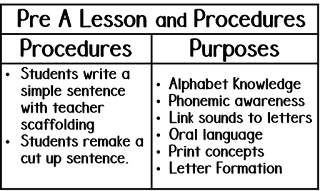Hey there Kinder Tribe! It's Jill from Chevron and Centers. I am excited to share chapter 4 of The Next Step Forward in Guided Reading with you!! I also had the previous version of this book. I love this one! The layout is very teacher friendly and is a great guide for your small group instruction.
We all know how important guided reading is with our kinders. Let's take a look at what to do with your early readers- those children who are reading on level D-I. I love how Amanda shared the guided reading lesson plan last week. This layout is discussed in this chapter as well. I love how this format can be used with any reader.
Day One:
Sight Word review
Introduce new book
Read book with prompting
Discuss/Teach
New Sight word
Word study
Day Two:
Sight Word review
Reread book
Discuss/Teach
Reteach sight word
Guided Writing
Most of our kinder kiddos are reading on levels A-C. When we begin guided reading groups that is where the majority of our kids fall. We do have those kids that come in ready to read and quickly move to level D and beyond. Early readers know letters and sounds and are reading and writing sight words.
Through our guided reading instruction Richardson tells us we want to help them learn how to:
- monitor their reading for meaning and structure
- reread for meaning
- use a variety of strategies to solve words
- apply phonetic principles they have learned
- retell what they have read
Richardson points out that the ultimate goal of a guided reading lesson is comprehension. This past school year I had a very high class. I had 85% of my class reading on level E or higher at the end of kindergarten. I teach in a Title 1 school and this is a rare thing! I was excited about what I could do with my kids but also worried about how to move them. I'm not going to lie it wasn't easy ha! Following the lesson plan format discussed in this book is a game changer though!
I needed to add higher level text and I found this set on TPT from A Teachable Teacher. She also has another pack that are leveled passages from J-O that I purchased as well for my super high readers.
I loved these and so did my kids. Children that are reading at levels E-I need to build fluency and comprehension. These passages are perfect for small group instruction. Here is a sample below. 

These passages lend themselves to Richardson's lesson plan format for guided reading. I enjoyed the fact that the passages were not so long that we didn't have time to get to the word building part of the lesson. The comprehension questions at the end were a great way to start that part of the lesson. They were also a good way to lead into guided writing.
Another topic discussed in this chapter is running records. Richardson suggests doing formal running records 3 times a year beginning, middle and end. We use Fountas and Pinnell. Kindergarten is required to do a formal benchmark test in January, March and May. Of course if you have readers coming into the year you would assess them then. I do weekly assessments with my kids at small group. I have a binder that has a section for each child. I jot my notes down on sticky notes. This lets me know quickly what strategies we need to focus on to with each child/small group.
Thanks for stopping by to read about chapter 4 in our book study! Head on over to our facebook page and let us know if you have any question!































